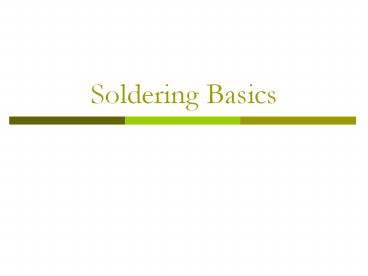Soldering Basics - PowerPoint PPT Presentation
Title:
Soldering Basics
Description:
Soldering Basics – PowerPoint PPT presentation
Number of Views:352
Avg rating:3.0/5.0
Title: Soldering Basics
1
Soldering Basics
2
Overview
- Introduction
- Definition
- Equipment
- Procedure
- Preparation
- Execution
- Finishing
- Specific Techniques
- Desoldering
- Tinning
- Conclusion
- References
3
Introduction Definition
- Unite two base metal items
- Add filler metal (solder)
- Typ. lt 842F (450C) melting point
- Metal flows via capillary action
- Metal bonds via wetting action
- Metallurgical joint exhibits
- Fair mechanical strength
- Excellent electrical conductivity
- Watertightness
4
Introduction Common Usage
- Electronics
- Plumbing
- Stained glasswork
- Jewelry
- Orthodontics
5
Introduction Equipment
- Solder
- Joint filler metal
- Metallic alloy
- Sn/Pb
- Typ. 60/40 or 63/37 mix
- 60/40 melts _at_ 374F (190C)
- 60/40 melts _at_ 364F (183C)
- Pb-free
- EU RoHS compliance
- Typ. Sn/Ag/Cu alloy
- Melts _at_ 422433F (217223C)
6
Introduction Equipment
- Flux
- Removes base, filler metal oxides
- Aids wetting process
- Rosin-based flux
- Availability
- Separate paste
- Flux-in-core solder
- Primary fume component
7
Introduction Equipment
- Soldering Iron
- Solder melting heat source
- Power rating
- Higher power ? higher tip temp
- Higher power ? heat larger joints
- 15-35W for electronic work
- Various tips available
- Conical, chisel types
- Tip width 70-90 contact width
- Never use cold heat irons on electronics!
8
Introduction Equipment
- Solder wick
- Braided copper strands
- Flux impregnated
- Absorbs solder when heated
- Remove excess solder
- Desolder components
- Solder stand sponge
- Always return iron when unused
- Always clean tip
- Remove burnt flux
- Remove excess solder
9
Introduction Equipment
- Heat sink
- Protect heat sensitive components
- Clip between component body and iron
- Substitution
- alligator clips
- Hemostat
- 99 alcohol brush
- Clean joint residual flux
- Purity important
10
Procedure Preparation
- Clean components
- Remove dirt, grease, oxidation
- Causes unwettability
- Solder tend to bead up
- Component leads bright, shiny
- Solder pads bright copper color
- Fine steel wool, emery cloth
11
Procedure Preparation
- Prepare iron
- Plug in iron
- Dampen sponge
- Clean tip w/ sponge
- Apply solder to iron tip (tinning)
- Wipe excess solder
- Tip should be have silvery sheen
12
Procedure Execution
- Place component
- Bend leads to fit hole pattern
- Insert component through correct holes
- Clinch leads slightly outward to hold in place
- Attach heat sink if needed
13
Procedure Execution
- Solder component
- Wipe iron w/ sponge
- Apply tiny solder amount to iron tip
- Not solder to form joint
- Helps conduct heat properly
- Touch tip side to BOTH pad and lead
- Add bit more solder to form heat bridge
- Wait for joint to be heated (1-2 sec)
14
Procedure Execution
- Solder component (cont.)
- Feed small solder amount from opposite side
- Molten solder should spread and fill joint
- Move solder away first
- Move iron away quickly
- Return iron to stand
- Entire process 5 sec
- Wait additional 3-5 sec for joint cooling
15
Procedure Inspection
- Inspect joint quality
- Good joint
- Shiny
- Bright
- Smooth
- Concave solder fillet
- Good wetting
16
Procedure Inspection
- Inspect joint quality (cont.)
- Bad joints
- Balled up or spiked
- Dull color
- Crystalline or grainy looking
- Convex solder fillet
- Dewetted
- Causes
- Dirty leads, pads
- Movement during cooling
- Overheating
17
Procedure Finishing
- Return iron to stand
- Cut excess lead length
- Clean residual flux w/ alcohol
- Prevent future oxidation
- Prevent unwanted electrical shorts
18
Techniques - Desoldering
- Repair bad joints
- Remove solder bridges
- Excess solder connects two pads, leads
- Unwanted electrical connection formed
- Remove components
- Both require old solder removal
- Place solder wick against solder joint
- Heat wick opposite side from joint
- Solder should wick up braid
- Remove braid first
- Remove and return iron to stand
19
Techniques Wire Tinning
- Must tin wires before soldering to components,
board - Attach heat sink just below insulation
- Heat wire end
- Touch solder to wire opposite iron tip
- Solder should wick up wire
- Too much heat damages wire insulation
20
Conclusion
- Introduction
- Definition
- Equipment
- Procedure
- Preparation
- Execution
- Finishing
- Specific Techniques
- Desoldering
- Tinning
21
References
- www.curiousinventor.com/guides/How_To_Solder
- www.aaroncake.net/electronics/solder.htm
- www.qsl.net/n9zia/solder.html
- www.solderinguide.com
- itp.nyu.edu/physcomp/Tutorials/SolderingAPerfBoard
- www.modchipworld.co.uk
- www.drmsmetals.com/data/electronic/erzin.html
- www.hsl.gov.uk/capabilities/rosin.htm
- www.sparkfun.com
- www.howardelectronics.com
- www.ladyada.net
- www.uelectronics.info
- us.geocities.com/steves_workshop
- www.theavenuestaineglass.com































